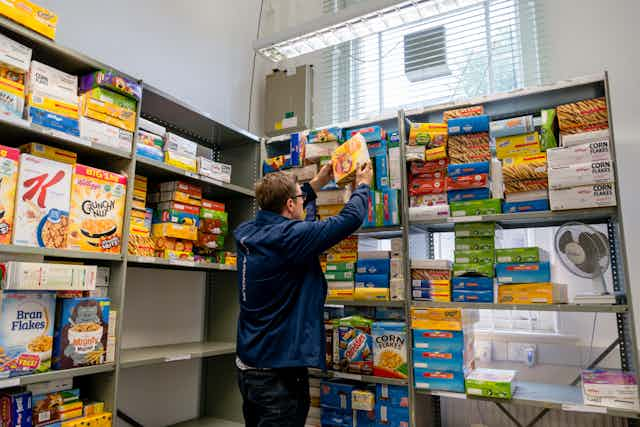Once relatively unheard of in the UK, the number of food banks has grown dramatically in recent years. The Trussell Trust, which runs the country’s largest network of food banks, saw the number of food parcels it distributed increase from 61,500 in 2010-11 to 1.33m by 2017-18 – a 21-fold increase.
The cause of this increase has been hotly debated, but evidence suggests that austerity and changes to social security have played a significant role.
Our new research explored the housing situation of food bank users across Britain for the first time. We found the vast majority are living in significantly difficult circumstances that are likely to contribute to their need for food bank support.
Housing problems
Housing support is one area of social security that has been particularly hard-hit by austerity. Changes to the local housing allowance have significantly reduced the amount of housing benefit private renters can receive, and introduced a penalty for “under-occupying” social housing, known as the bedroom tax.
A cap on the amount of benefits people can receive has also had a significant impact on housing support. Housing and food are two household essentials, but where resources are scarce, spending on food is often more flexible than spending on housing. A recent survey by the housing charity Shelter found that 20% of low-income renter households had cut back on food in order to meet their housing costs. However, little is known about the housing situations of food bank users.
Our study used data from a survey of 598 Trussell Trust food bank users conducted between October 2016 and April 2017 in Britain. The results are stark. Over four-fifths of food bank users reported at least one significant housing problem including rent arrears, difficulty affording rent, poor housing conditions, or homelessness. Nearly 18% of users were homeless, and an additional 15% of respondents had slept rough in the past 12 months. By comparison, estimates suggest about 0.005% of the population are homeless.
Of those surveyed, 8% didn’t have access to adequate cooking facilities, further reducing their ability to prepare food and meet their nutritional needs. A third had experienced an increase in their housing costs, including utilities, in the three months prior to attending the food bank, with approximately a quarter of renters – both social and private – finding it very difficult to pay their rent. Nearly 60% couldn’t afford to adequately heat their homes, an indicator of destitution.
Social renters over-represented
Renters were also over-represented among food bank users. Excluding homeless households, approximately 18% of all UK households live in the social rented sector such as accommodation owned by the local authority or housing association, and 20% in the private rented sector. However, among food bank users, we found levels were much higher: of food bank users who weren’t homeless, 57% were social renters and 38% private renters.
In part, the over-representation of social renters could reflect the fact that in order to access a food bank, users must first be referred. Social housing providers have the ability to make these referrals, while private landlords do not. It’s likely this also reflects that social housing is generally provided only for those most in need, although this varies somewhat as housing is a devolved matter.
The social rented sector is also home to a high number of very low-income households and a higher proportion of households which include disabled people. Disability increases living costs and is a risk factor for deep poverty, particularly following changes to disability benefits.
Read more: Benefit changes will entrench the poor in 'food bank Britain'
Difficulties for private renters
Rents are higher in the private rented sector, averaging £193 per week in England in 2017-18 compared to £103 in the social rented sector. Private rents have risen faster than both housing benefit and earnings for some time, with housing benefit now covering the full rent for just 10% of low-income private renters.
Private renting is also less secure and, on average, provides lower-quality housing than the social sector. This is reflected in what food bank users told us about their perceptions of housing security and issues with their home.
One in seven private renters thought they would “definitely” be forced to move out of their home in the coming 12 months, compared to one in 24 social renters, suggesting that social renting provided some stability. Yet, frequent moves were a feature for many of the survey respondents: 42% had moved in the last 12 months (rising to nearly 47% for private renters) compared to approximately 9% of households in England overall.
Our results support claims that the increase in food bank use is due to government decisions around social support, rather than individual failings, demand for free goods, or lack of skills. The poor housing situations of food bank users emphasise the extreme hardship that they face and the inadequacy of stop-gap food aid to address this problem. Instead, comprehensive support is required, requiring the government to rethink its approach to social security.
A good place to start would be to recalculate housing benefit so that it once again reflects the rent people have to pay, and to make sure it keeps up with changes to the rents that people pay. Alongside this, the current benefit cap should be removed so that people receive the assistance they need to afford decent food and homes.

